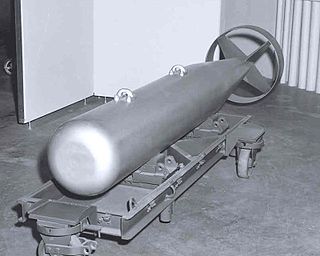- Mark 8 nuclear bomb
-
The Mark 8 nuclear bomb was a nuclear bomb designed late 1940s and early 1950s, which was in service from 1952 to 1957.
Contents
Description
The Mark 8 was a gun type nuclear bomb, which rapidly assembles several critical masses of fissile nuclear material by firing a fissile projectile or "bullet" into a hollow opening in a larger fissile "target", using a system which closely resembles a medium sized cannon barrel and propellant.
The Mark 8 was an early earth penetrating bomb (see nuclear bunker buster), intended to dig into the earth some distance prior to detonating. According to one government source, the Mark 8 could penetrate 22 feet (6.7 m) of reinforced concrete, 90 feet (27 m) of hard sand, 120 feet (37 m) feet of clay, or 5 inches (13 cm) of hardened armor plate steel. [1]
The Mark 8 was 14.5 inches (37 cm) in diameter across its body, 116 to 132 inches (290 to 340 cm) long depending on submodel. It weighed 3,230 to 3,280 pounds (1,470 to 1,490 kg), and had a yield of 25-30 kilotons.
A total of 40 Mark 8 bombs were produced.
The Mark 8 was succeeded by an improved variant, the Mark 11 nuclear bomb.
Variants
The Mark 8 was considered as a cratering warhead for the SSM-N-8 Regulus cruise missile. This W8 variant was cancelled in 1955.
A lighter Mark 8 variant, the Mark 10 nuclear bomb, was developed as a lightweight airburst (surface target) bomb. The Mark 10 project was cancelled prior to introduction into service, replaced by the much more fissile material efficient Mark 12 nuclear bomb implosion design.
See also
External links
- Allbombs.html list of all US nuclear warheads at nuclearweaponarchive.org
References
- ^ Weapon Design: We've done a lot but we can't say much by Carson Mark, Raymond E. Hunter, and Jacob E. Weschler, Los Alamos Science, Winter/Spring 1983, pp 159.
Categories:- Cold War nuclear bombs of the United States
- Gun-type nuclear bombs
Wikimedia Foundation. 2010.



